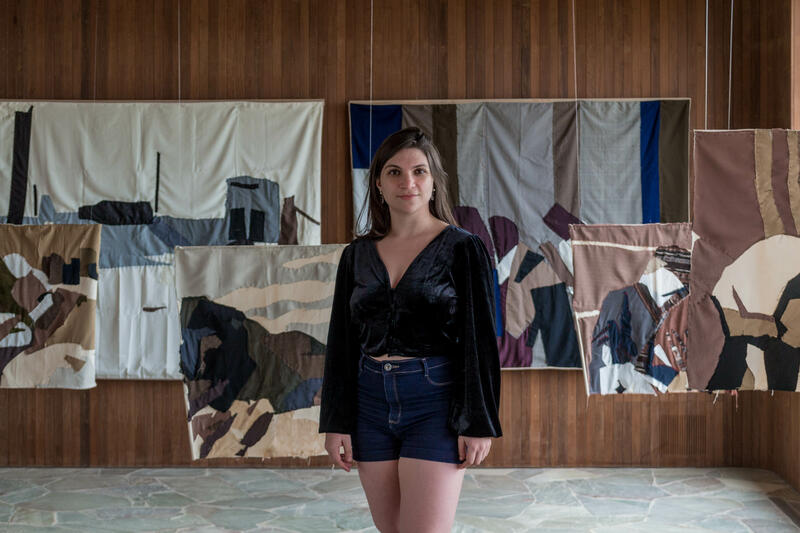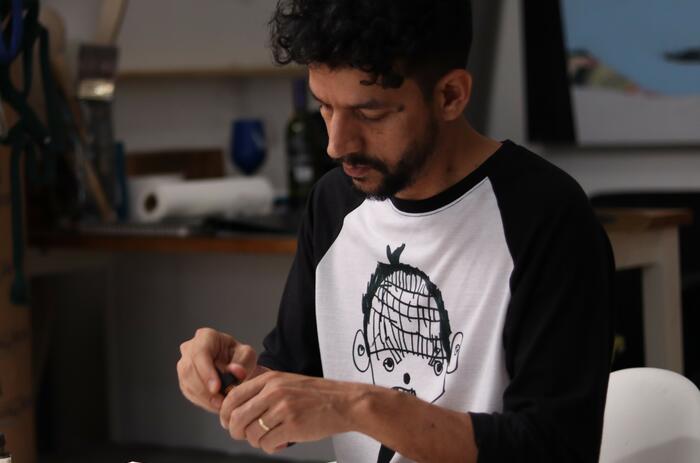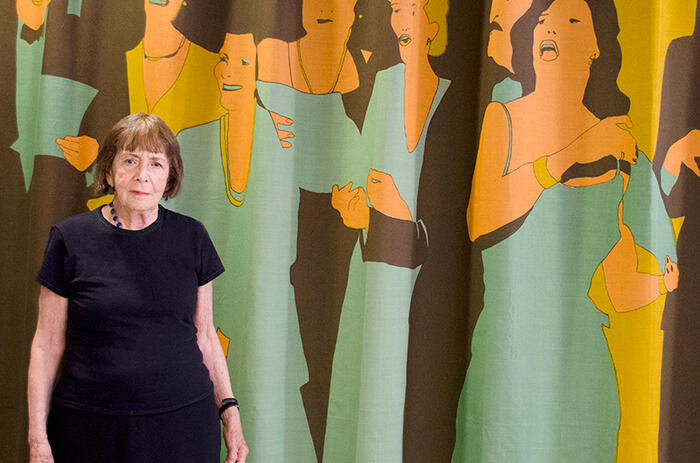RETHINKING HISTORY THROUGH THE LENS OF LANGUAGE: AN INTERVIEW WITH ELIÁN STOLARSKY
Elián Stolarsky’s house is not hard to spot. A building with a vine on the entrance wall is such a rarity in the center of Madrid. Not so in Montevideo, where she comes from. Everything grows slowly there, everything is carefully traversed by time. Elián opens the front door for me and we walk down a narrow corridor to the last apartment on the first floor. Her flat is also her studio: an airy one-room apartment with high ceilings and the bedroom on a mezzanine. The desk is piled up with books, boxes and sticky notes with scribbled ideas and doodles. Elián Stolarsky is a drawer, printmaker and visual artist. In short, an artist - probably one of the most outstanding figures of Uruguay’s emerging new generation of artists.
In 2018, at only 28 years of age, the National Museum of Visual Arts in Montevideo (MNAV) held a solo exhibition of her work Y todos los otros, where she reconstructs her family’s Jewish past, explores the construction of Polish identity after World War II emigration and, ultimately, creates a historical archive of a generation through printmaking, textile art and animation. Since 2015 she has been living in Europe: first she lived in Belgium, where she enjoyed a residency in the Frans Masereel Centrum’s program, and now she is in Spain, where she arrived to be part of Casa Velázquez’s residency program and where she remains.

(Trans. Paula Colmenares León)
. How did you get into printmaking and how did your approach develop?
I have always drawn. I come from a family of architects, and my father used to take me to see exhibitions when I was a child. On the other hand, my sister is a designer and a dancer, so I grew up in a very artistic environment. I started drawing a lot and got into printmaking as an inevitable consequence, because of the way I was drawing. At that time I was fascinated with a book of Rembrandt etchings we had at home.
It was a consequence, but also a coincidence. Or one of those things that can happen in a more horizontal art scene such as the one found in Uruguay, Argentina or Chile. In an exhibition at the Uruguayan space Fundación Unión (a space that no longer exists) there was among the displayed artists one who worked with printmaking: Edgardo Flores. Captivated by Flores’ prints, Stolarsky approached the artist and managed to be accepted in his workshop.
He was my very first teacher and, possibly, my first referent. But it was a seamless introduction, over the years one technique led to another. It was very intuitive. Then came the methacrylate and all the possibilities offered by its transparency - that allows printing on both sides -, later came the textiles... One thing led to another.
. What is the point of using printmaking as a language of memory today?
That is something people often challenge me about. But language is a very important element in my creative process. Words, for example, are very present in my work and in my worldview (in everybody’s worldview, of course, language is decisive), and the fact that the word ‘printmaking’ has two meanings - printmaking as such, as a technique, and printmaking as that which is registered, or that which leaves a trace, imprinting a memory on the material - endows it with meaning. The same goes for methacrylate. When I began to experiment, the material itself offered different possibilities: transparency, light, shadow. The whole set became an almost metaphysical, even spiritual learning process.
In short, art provides a material experience. And it is from that stance that I was confronted with a path where I felt like I needed to tackle the issue of memory and identity. Going back to the idea of methacrylate, for example, it is a medium that allows you to work in layers and develop a constructive process... Isn’t that how memory works?
. What about textiles?
I turned to textiles when I was in Belgium. At that moment, I wanted to change my approach, a process I’m still working on. So the first step was to cross the Atlantic to study and find my way. I shared a room in a tiny student apartment with eight other students. When you are a student, you are a second-class citizen. It was under that condition that I began to experiment with printmaking on fabric. But I was trying to combine two techniques into one and I found it somewhat incompatible, the medium wouldn’t give me what I wanted. Or my method was still lacking some refinement in the encounter between the two languages. And I began to interact more with the fabric. I began to print, cut and play with scraps.
From one moment to the next, I found myself in my room sewing for hours on end. And not only did the work turn out well, but it was also a very practical work process: I could function in a tiny space, storing my body of work was very easy... It was a period in which I felt like I was living inside a set design.
Elian Stolarsky’s work, or at least her last two major exhibitions - Y todos los otros, at the MNAV in Montevideo, and Inventario 17, held within the framework of the new Uruguayan itinerant gallery project LÍQUIDO, led by Valentín Benoit - proposes a sort of reorganization of history. “Of cataloguing the uncategorizable,” she says.
Her pieces, devised in horizontal compositions, are conceived in series that exhaust repetition, to the point of transforming the image by means of a difference that ends up imposing itself on the totality of the series. According to the artist herself, that dynamic allows her to represent the brutality of the Holocaust, permeated by an aesthetic based on repetition and numbering.
. The blending of fact and fiction is evident in your work, how much of what is represented responds to History and how much to storytelling?
I think I am constantly oscillating between the two poles: the historical and the oral, fact and hearsay. In part, my obsession with time stems from the fact that I don’t quite understand how it works. It presents itself to me in the form of a question. This back and forth is also one of the reasons why I am exploring animation as an expressive medium. Since it is a device that takes place in time, it offers you linearity, even when you intend not to present History as linear (History is not so).
As for fiction... As Didi-Huberman[1] suggests, it is what makes it possible to put together certain scraps of history, to rethink the unthinkable. We are constantly looking for a logic of composition, and so the need for a narrative arises. And what is important lies in the relationships that make up a content. For example, what is it that makes the relationship between two cells become blood and not something else? Each element has a... let’s call it “potency,” and the value is in that in-between that takes place between both potencies.
. In her L’enracinement, Simone Weil presents the past as one of the most vital needs of the soul,[2] because the future offers nothing, and a society can only be (re)built from the past. In your case, do you understand memory as a social tool?
Definitely. On the one hand, it is the need to retain history in order to tell it to others. It is a sort of universal library that enriches us all. On the other hand, it constitutes, together with stories, the space in which the social fabric is formed: I have a story to tell and I need someone else to listen to it.
. And in the case of your family history, what is it worth preserving and telling?
The identity of the Jewish people is an identity founded on rootlessness. It is a culture that proclaims itself because it doesn’t have a homeland. Under such condition, objects, let’s say a book, become a homeland. And in this context, the objects that conform a culture allow for an identity to go beyond its physical location.
In my particular case, I have brought my rootlessness upon myself. I reversed, physically and symbolically, the path my ancestors took. They fled to South America because of persecution, I migrated freely to Europe. Coming from a generation in which, apparently, the world offered us everything.
-
"Inventario 17", Elián Stolarsky, vista de sala en Posada Ayana, José Ignacio, Uruguay. Ph: cortesía LÍQUIDO.
-
"Inventario 17", Elián Stolarsky, vista de sala en Posada Ayana, José Ignacio, Uruguay. Ph: cortesía LÍQUIDO.
-
"Inventario 17", Elián Stolarsky, vista de sala en Posada Ayana, José Ignacio, Uruguay. Ph: cortesía LÍQUIDO.
-
"Inventario 17", Elián Stolarsky, detalle de obra en Posada Ayana, José Ignacio, Uruguay. Ph: cortesía LÍQUIDO.
For Stolarsky, the responsibility of an artist - should the very condition of being an artist demand from them a commitment that others are not required to make - is to express a perspective. The position of those who work within the artistic field, she says, is political inasmuch as they transcend the circumstantial and place themselves in the realm of the production of meaning. “That is only feasible if you take a stance. That’s why artistic endeavors that claim objectivity bother me a lot,” she adds. This commitment to subjectivity, as defined by Stolarsky, is obviously subjected to the dynamic character of subjectivity. And here it is impossible not to recall, once again, one of Weil’s ideas: “In thought there is a three-dimensional space.” That which does not offer a standpoint, as is the case for material reality, is an illusion.
To conclude, let us turn to an idea of Boris Groys. Groys states that philosophers, from the emergence of modernity until now, have shifted from a sphere of contemplation to a sphere of work. That is to say that nowadays even philosophers are unable, in their work, to remove themselves from the institutional framework (academic or mercantile) in which they pursue their work. If we extrapolate this idea to the condition of the artist, who is embedded in a great scheme called “art industry,” what ways do you have to take a step aside and seek, let’s say, to enter a dimension that may transcend that scheme?
To work as a UX designer. Basically, to work as something else. It’s a decision I deliberately made as an artist, to keep myself on the margins. To not make a living out of it. Therein lies the difference between the craftsman and the artist, right? As long as my income does not depend on my work as an artist, I can allow myself to work on my own time, to invest the time I deem necessary for each project, instead of working along the lines set by the market.
Now, if it so happens that my work is in line with a certain trend, I am not going to say no - all the better. But it seems to me that the ideal way to take a step away from that institutional or mercantile scheme is to move away from the axis. Now more than ever, it’s better to find another way to make a living.
[1] Images in Spite of All: Four Photographs from Auschwitz, Georges Didi-Huberman (University of Chicago Press, 2008).
[2] “A human being has roots by virtue of his real, active and natural participation in the life of a community which preserves in living shape certain particular treasures of the past and certain particular expectations for the future”, The Need for Roots: Prelude to a Declaration of Duties Towards Mankind, Simone Weil (Routledge, 2001).






